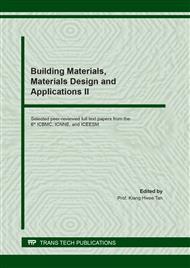[1]
Chua, C. K., Leong, K. F., & Lim, C. S. (2003). Rapid prototyping: Principles and applications. (NetLibrary.) Singapore: World Scientific.
Google Scholar
[2]
Buj-Corral I., Domínguez-Fernández A., & Durán-Llucià R. (January 01, 2019). Influence of Print Orientation on Surface Roughness in Fused Deposition Modeling (FDM) Processes. Materials, 12, 23.).
DOI: 10.3390/ma12233834
Google Scholar
[3]
Ngo, T. D., Kashani, A., Imbalzano, G., Nguyen, K. T. Q., & Hui, D. (January 01, 2018). Additive manufacturing (3D printing): A review of materials, methods, applications and challenges. Composites.part B, Engineering, 143, 172-196.
DOI: 10.1016/j.compositesb.2018.02.012
Google Scholar
[4]
Yasa, E., Poyraz, O., Solakoglu, E. U., Akbulut, G., & Oren, S. (January 01, 2016). A Study on the Stair Stepping Effect in Direct Metal Laser Sintering of a Nickel-based Superalloy. Procedia Cirp, 45, 175-178.
DOI: 10.1016/j.procir.2016.02.068
Google Scholar
[5]
Ayrilmis, N. (October 01, 2018). Effect of layer thickness on surface properties of 3D printed materials produced from wood flour/PLA filament. Polymer Testing, 71, 163-166.
DOI: 10.1016/j.polymertesting.2018.09.009
Google Scholar
[6]
Hartcher-O'Brien, J., Evers, J., & Tempelman, E. (June 01, 2019). Surface roughness of 3D printed materials: Comparing physical measurements and human perception. Materials Today Communications, 19, 300-305.
DOI: 10.1016/j.mtcomm.2019.01.008
Google Scholar
[7]
Nagendra, J., Srinath, M. K., Sujeeth, S., Naresh, K. S., & Ganesha, P. M. S. (January 01, 2020). Optimization of process parameters and evaluation of surface roughness for 3D printed nylon-aramid composite. Materials Today: Proceedings.
DOI: 10.1016/j.matpr.2020.10.609
Google Scholar
[8]
Chaudhari, M., Jogi, B. F., & Pawade, R. S. (January 01, 2018). Comparative Study of Part Characteristics Built Using Additive Manufacturing (FDM). Procedia Manufacturing, 20, 73-78.
DOI: 10.1016/j.promfg.2018.02.010
Google Scholar
[9]
Wankhede, V., Jagetiya, D., Joshi, A., & Chaudhari, R. (January 01, 2020). Experimental investigation of FDM process parameters using Taguchi analysis. Materials Today: Proceedings, 27, 2117-2120.
DOI: 10.1016/j.matpr.2019.09.078
Google Scholar
[10]
Khan, M. S., & Mishra, S. B. (January 01, 2020). Minimizing surface roughness of ABS-FDM build parts: An experimental approach. Materials Today: Proceedings, 26, 1557-1566.
DOI: 10.1016/j.matpr.2020.02.320
Google Scholar
[11]
Milde J., & Morovič L. (January 01, 2016). The Influence of Internal Structures in Fused Deposition Modeling Method on Dimensional Accuracy of Components. Research Papers. Faculty of Materials Science and Technology. Slovak University of Technology in Trnava, 24, 38, 73-80.
DOI: 10.1515/rput-2016-0041
Google Scholar
[12]
Morovic, L., & Milde, J. (January 01, 2017). Influence of part orientation on geometrical and dimensional accuracy in FDM method. Academic Journal of Manufacturing Engineering, 15, 1, 24-28.
Google Scholar
[13]
Milde, J., & Jurina, F. (January 01, 2019). Comparison of selected thermoplastic materials in the fused deposition modeling process and their influence on the dimensional accuracy of an orthodontic upper teeth model. 952.
DOI: 10.4028/www.scientific.net/msf.952.143
Google Scholar
[14]
Milde, J., Hrusecky, R., Zaujec, R., Morovic, L., & Gorog, A. (January 01, 2017). Research of ABS and PLA Materials in the Process of Fused Deposition Modeling Method. 812-820.
DOI: 10.2507/28th.daaam.proceedings.114
Google Scholar
[15]
Pandey, P. M., Thrimurthulu, K., & Reddy, N. V. (January 01, 2004). Optimal part deposition orientation in FDM by using a multicriteria genetic algorithm. International Journal of Production Research, 42, 19, 4069-4089.
DOI: 10.1080/00207540410001708470
Google Scholar
[16]
Ahn, D., Kweon, J.-H., Kwon, S., Song, J., & Lee, S. (August 01, 2009). Representation of surface roughness in fused deposition modeling. Journal of Materials Processing Technology, 209, 5593-5600.
DOI: 10.1016/j.jmatprotec.2009.05.016
Google Scholar
[17]
Olivera, S., Muralidhara, H. B., Venkatesh, K., Gopalakrishna, K., & Vivek, C. S. (April 01, 2016). Plating on acrylonitrile-butadiene-styrene (ABS) plastic: a review. Journal of Materials Science : Full Set - Includes `journal of Materials Science Letters', 51, 8, 3657-3674.
DOI: 10.1007/s10853-015-9668-7
Google Scholar
[18]
Khoo, Z. X., Teoh, J. E. M., Liu, Y., Chua, C. K., An, J., Leong, K. F., Yeong, W. Y., ... Yang, S. (July 03, 2015). 3D printing of smart materials: A review on recent progresses in 4D printing. Virtual and Physical Prototyping, 10, 3, 103-122.
DOI: 10.1080/17452759.2015.1097054
Google Scholar


